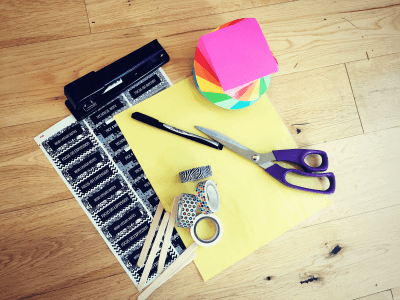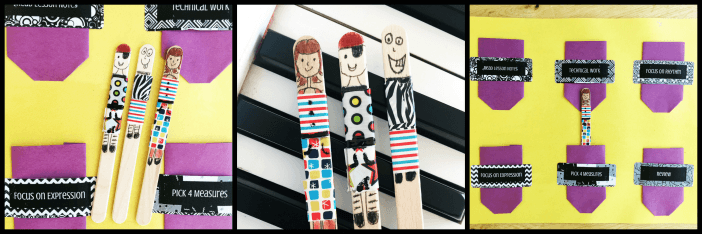I wish I could be a fly on the wall in my piano students’ practice rooms. I wish I could see what actually happens. I’m sure the experience would be eye opening (or eyes opening… flies have thousands after all).
I don’t doubt that my students practice. In fact, I know that my students practice. But what is not always so clear, is how they practice.
For many young piano students, practice is more or less a run through of their pieces. But effective piano practice is so much more than that! Effective piano practice requires a clear and concise practice routine that is followed every single time. Home piano practice should have structure, just as a piano lesson has structure.
But teaching kids how to structure home practice can feel like pulling teeth. So instead, my students and I have been building cute little DIY Home Practice Planners to teach them the different activities they should do each and every time they sit down at their pianos to practice. Interested in making one? Here’s how…

How To Make A Washi Tape Home Practice Planner
If you want your littlest piano students to practice often and effectively, not only do you have to show them how to practice, but you have to help them take ownership of their practice. By building their own DIY Home Practice Planner your piano students will be way more motivated to take practice action than if you simply hand them a ready-to-print practice checklist.
Step 1: What You Will Need…
To build a Washi Tape Home Practice Planner you will need washi tape, popsicle sticks, a black-tipped felt pen, scissors, card stock (or a laminated piece of paper), post-it notes, a stapler and our practice routine labels found here (or your own if you have different needs).

Here are some pictures of what you’ll be making. It’s a 6-pocket chart that your students keep beside their piano at home. Each pocket is labeled with a practice task. Your popsicle sticks become adorable “practice pals” with the addition of some washi tape and some imagination – you can do animals, people, aliens… you name it! The Practice Pals move from pocket to pocket as each task is completed.

Step 2: How To Explain It
With your students, discuss the 6 home practice tasks are listed on our practice routines labels that you printed during Step 1. These include:
- Read Lesson Notes: Read over the practice tasks for the week
- Technical work: This includes scales, TEDDtales, triads, warm-ups etc.
- Focus on Rhythm: Play their assigned pieces with a focus on the rhythm (for my students this means to do this)
- Focus on Expression: Play their assigned pieces with a focus on phrasing, dynamics and articulation
- Pick 4 Measures: Choose 4 measures that were difficult and/or needed extra attention and spend extra time on those.
- Review: Choose 2 “old” pieces and review them.
Step 3: How To Build It
Working with your students, build the Washi Tape Home Practice Planner together. Rather than explain the process in writing, I’ve included a quick little video below where you can watch me put on my “crafty hat”. Feel free to modify the craft as needed to include the practice tasks that suit your studio. This makes a fabulous group piano party activity too!
Step 4: How To Use It
Using it is simple. At home, your students tape the practice planner to a visible location near their piano and place their “Popsicle Practice Pal” in the first pocket. Their practice session then begins with the task listed on this pocket. Upon completion of that task, your students move their Popsicle Practice Pal to the next pocket and complete the corresponding labelled task. Your students then repeat this process until their practice pals reach the final pocket… signalling an end to the home practice session.
Piano Practice Is Easier With Motivating Music!
Effective practice becomes SO much easier when your piano student has motivating repertoire to practice. PianoBookClub makes this easy by sending you a brand new book full of music every month for just $8! Practice routines will never become stale with the addition of exciting new repertoire! Check it out here.

I love this!
Thank you…
You’re welcome Elaine! 🙂 Have fun with it!
Hi, (here is Javier from Barcelona, Spain)
thanks for all your ideas …
I love this too!
Hi Javier! Thanks for reading – glad you’re finding the ideas useful 🙂 We LOVE Spain – what a beautiful country you live in!
Was just experimenting with something similar today! ☺
Such a cute idea! I definitely want to make these with the kids. Are those address labels you used to print the practice labels?
Yes – Avery 5160 template 🙂
This. Is. AWESOME! Have a class coming up next week and we are definitely making these! Thank you!
Thank you thank you thank you!!!
Thank you! Thank you! I just love this. I have left over foam pieces from summer camp that I can use for the base!
Perfect Mary! That would work great 🙂 Not sure if labels would stick to foam, but you could staple them down perhaps. Have fun with it!
I have group lessons scheduled later this month. We will be doing this!! Thank you.
Hi Karen – Wonderufl! Yes, it’s the perfect activity for a group piano party or class – it’s easy enough that kids can complete it all on their own and the materials are not the slightest bit expensive 🙂
Too cute! Love it.
This practice craft is perfect timing. I have a 5yr old boy who really struggled focusing on his lessons. One day he was telling me about Ninjas and I added that there were piano Ninjas too and that our fingers were our weapons, the song our enemy to conquer. That worked like a charm. We also rename every song and the titles he comes up with are pretty incredible. Our imaginative story line has taken a space robot twist lately, but for as long as he speaks that language we will keep on with it. His mom mentioned that they were having a hard time practicing during the week. So I will be using this activity and we will be creating Space Ninjas and Space Robots on our popsicle sticks. I will likely add a story line to it as well to encourage more days of practice.
… unrelated, I have a pre-teen student who told me that she only wants to play songs by Andrea Dow. We are working through the Pop Waltz prophecy right now.
How lucky he is to have you Krista! Learning to meet the student where he is and to “speak his language” is a mark of a truly great teacher 🙂
Beyond flattered to hear of your pre-teen’s “Andrea Dow only” diet 😉
Quick question! What is the ‘style/size’ of the Avery labels that you used that match the template?
Thanks in advance
and
A BAZILLION times a MILLION thanks for all you do to make teaching a much more rewarding and easier experience.
Hi Michele – they’re the standard address ones 5160 🙂
Brilliant, thank you so much!
I would love to see an example of your
“Lesson notes”, what they are to read over in step number 1.
Hi Louise – I use a template for lesson notes like the ones we share in this blog post : https://www.teachpianotoday.com/2014/09/07/a-printable-to-add-some-pizzazz-to-your-piano-lesson-assignment-binders/
This is so awesome! I have been searching for something like this. Thank you!
Wonderful Keera! Thanks for reading our blog 🙂
Another brilliant idea! This blog is always inspiring- keep it up!
Thank you Maria!
ilovely idea!! thanks for sharing, your work is inspiring! thanks! Evangelina from Argentina
Thank you for this creative and very helpful idea! I am going to try an adaptation of this idea by using a printable race track (with start and finish lines) I found online. The practice labels can be glued in order on the track, and the student can move a Hot Wheels or similar car along the track as tasks are completed.
Thanks for this great idea! We’ll be doing this for our Winter Piano Party next weekend…only we’ll use those baseball sheet-protector pages (9 pockets) and just insert instruction cards into each one. That way the tasks can be customized to the student’s level, and when we have something special on the horizon (like recital preparation) we can change up the task cards to suit the need.
What is the significance of 3 practice pals. 3 pieces and they move one pal for each song they are working on?
Hi Sam – each student just has one “practice pal popsicle stick” – our pictures showed three to demonstrate the different designs your students could create, but they just need one that moves from pocket to pocket. You could have more if you chose to 🙂
Is washi tape the same as the decorative duck tape?
I am to going to try this maybe using a 3hole subject divider so it would fit in a 3 ring binder. It would be oriented a little differently but I bet itwill work!
Another great creation of yours for making piano education more fun, organized, and motivating! Many thanks to you!
This is great and I am planning to use it for some of my group lessons next week! But I’m getting stuck trying to print the labels … I have an inkjet printer with Avery 8160 labels. Am I trying to use the wrong type of labels? Thanks 🙂